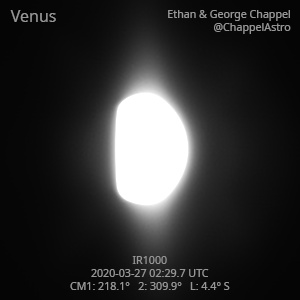
Venus UTC
CM1: 218.10°
CM2: 309.90°
CLat: -4.40°
Description
Second consecutive night of stable imaging conditions for Venus. We are now a few days beyond greatest elongation from the Sun.
After a successful attempt with relatively little data on the 26th, I assumed using more data would guarantee a better image of the night side, but I think that turned out wrong. My two ideas for why are either a slightly shorter exposure (300ms on the 26th, 280ms here) or the conditions were less favorable for catching 1000nm light.
Equipment
ZWO ASI174MM
Astro-Physics Advanced Convertible Barlow
Celestron EdgeHD 14
Logs
FireCapture v2.6 Settings ------------------------------------ Observer=Ethan Chappel Camera=ZWO ASI174MM Filter=IR1000 Profile=Venus Diameter=24.13" Magnitude=-4.37 FocalLength=9500mm (F/33) Resolution=0.13" Filename=2020-03-27-0318_4-EC-IR1000.ser Date=2020_03_27 Start=03_15_58.826 Mid=03_18_28.950 End=03_20_59.074 Start(UT)=03_15_58.826 Mid(UT)=03_18_28.950 End(UT)=03_20_59.074 Duration=300.248s Date_format=yyyy_MM_dd Time_format=HH_mm_ss LT=UT -6h Frames captured=1073 File type=SER Binning=no Bit depth=8bit Debayer=no ROI=464x486 ROI(Offset)=0x0 FPS (avg.)=3 Shutter=280.0ms Gain=400 (100%) AutoHisto=75 (off) Gamma=50 USBTraffic=80 Brightness=1 (off) AutoExposure=off SoftwareGain=10 (off) HighSpeed=off AutoGain=off FPS=100 (off) Histogramm(min)=0 Histogramm(max)=255 Histogramm=100% Noise(avg.deviation)=1.79 AutoAlign=false PreFilter=none Limit=300 Seconds Sensor temperature=28.1°C Focuser position=2047 FireCapture v2.6 Settings ------------------------------------ Observer=Ethan Chappel Camera=ZWO ASI174MM Filter=IR1000 Profile=Venus Diameter=24.13" Magnitude=-4.37 FocalLength=8950mm (F/31) Resolution=0.13" Filename=2020-03-27-0313_1-EC-IR1000.ser Date=2020_03_27 Start=03_10_38.461 Mid=03_13_08.577 End=03_15_38.693 Start(UT)=03_10_38.461 Mid(UT)=03_13_08.577 End(UT)=03_15_38.693 Duration=300.232s Date_format=yyyy_MM_dd Time_format=HH_mm_ss LT=UT -6h Frames captured=1073 File type=SER Binning=no Bit depth=8bit Debayer=no ROI=464x486 ROI(Offset)=0x0 FPS (avg.)=3 Shutter=280.0ms Gain=400 (100%) AutoHisto=75 (off) Gamma=50 USBTraffic=80 Brightness=1 (off) AutoExposure=off SoftwareGain=10 (off) HighSpeed=off AutoGain=off FPS=100 (off) Histogramm(min)=0 Histogramm(max)=255 Histogramm=100% Noise(avg.deviation)=1.79 AutoAlign=false PreFilter=none Limit=300 Seconds Sensor temperature=28.2°C Focuser position=2047 FireCapture v2.6 Settings ------------------------------------ Observer=Ethan Chappel Camera=ZWO ASI174MM Filter=IR1000 Profile=Venus Diameter=24.12" Magnitude=-4.37 FocalLength=9700mm (F/34) Resolution=0.12" Filename=2020-03-27-0307_8-EC-IR1000.ser Date=2020_03_27 Start=03_05_18.062 Mid=03_07_48.187 End=03_10_18.312 Start(UT)=03_05_18.062 Mid(UT)=03_07_48.187 End(UT)=03_10_18.312 Duration=300.250s Date_format=yyyy_MM_dd Time_format=HH_mm_ss LT=UT -6h Frames captured=1073 File type=SER Binning=no Bit depth=8bit Debayer=no ROI=464x486 ROI(Offset)=0x0 FPS (avg.)=3 Shutter=280.0ms Gain=400 (100%) AutoHisto=75 (off) Gamma=50 USBTraffic=80 Brightness=1 (off) AutoExposure=off SoftwareGain=10 (off) HighSpeed=off AutoGain=off FPS=100 (off) Histogramm(min)=0 Histogramm(max)=255 Histogramm=100% Noise(avg.deviation)=1.81 AutoAlign=false PreFilter=none Limit=300 Seconds Sensor temperature=28.5°C Focuser position=2047 FireCapture v2.6 Settings ------------------------------------ Observer=Ethan Chappel Camera=ZWO ASI174MM Filter=IR1000 Profile=Venus Diameter=24.12" Magnitude=-4.37 FocalLength=9600mm (F/34) Resolution=0.13" Filename=2020-03-27-0302_4-EC-IR1000.ser Date=2020_03_27 Start=02_59_57.703 Mid=03_02_27.817 End=03_04_57.931 Start(UT)=02_59_57.703 Mid(UT)=03_02_27.817 End(UT)=03_04_57.931 Duration=300.228s Date_format=yyyy_MM_dd Time_format=HH_mm_ss LT=UT -6h Frames captured=1073 File type=SER Binning=no Bit depth=8bit Debayer=no ROI=464x486 ROI(Offset)=0x0 FPS (avg.)=3 Shutter=280.0ms Gain=400 (100%) AutoHisto=75 (off) Gamma=50 USBTraffic=80 Brightness=1 (off) AutoExposure=off SoftwareGain=10 (off) HighSpeed=off AutoGain=off FPS=100 (off) Histogramm(min)=0 Histogramm(max)=255 Histogramm=100% Noise(avg.deviation)=1.78 AutoAlign=false PreFilter=none Limit=300 Seconds Sensor temperature=28.6°C Focuser position=2047 FireCapture v2.6 Settings ------------------------------------ Observer=Ethan Chappel Camera=ZWO ASI174MM Filter=IR1000 Profile=Venus Diameter=24.12" Magnitude=-4.37 FocalLength=9850mm (F/35) Resolution=0.12" Filename=2020-03-27-0257_1-EC-IR1000.ser Date=2020_03_27 Start=02_54_37.463 Mid=02_57_07.507 End=02_59_37.551 Start(UT)=02_54_37.463 Mid(UT)=02_57_07.507 End(UT)=02_59_37.551 Duration=300.088s Date_format=yyyy_MM_dd Time_format=HH_mm_ss LT=UT -6h Frames captured=1072 File type=SER Binning=no Bit depth=8bit Debayer=no ROI=464x486 ROI(Offset)=0x0 FPS (avg.)=3 Shutter=280.0ms Gain=400 (100%) AutoHisto=75 (off) Gamma=50 USBTraffic=80 Brightness=1 (off) AutoExposure=off SoftwareGain=10 (off) HighSpeed=off AutoGain=off FPS=100 (off) Histogramm(min)=0 Histogramm(max)=255 Histogramm=100% Noise(avg.deviation)=1.83 AutoAlign=false PreFilter=none Limit=300 Seconds Sensor temperature=28.7°C Focuser position=2047 FireCapture v2.6 Settings ------------------------------------ Observer=Ethan Chappel Camera=ZWO ASI174MM Filter=IR1000 Profile=Venus Diameter=24.12" Magnitude=-4.37 FocalLength=10000mm (F/35) Resolution=0.12" Filename=2020-03-27-0251_8-EC-IR1000.ser Date=2020_03_27 Start=02_49_22.192 Mid=02_51_52.202 End=02_54_22.212 Start(UT)=02_49_22.192 Mid(UT)=02_51_52.202 End(UT)=02_54_22.212 Duration=300.020s Date_format=yyyy_MM_dd Time_format=HH_mm_ss LT=UT -6h Frames captured=1072 File type=SER Binning=no Bit depth=8bit Debayer=no ROI=464x486 ROI(Offset)=0x0 FPS (avg.)=3 Shutter=280.0ms Gain=400 (100%) AutoHisto=75 (off) Gamma=50 USBTraffic=80 Brightness=1 (off) AutoExposure=off SoftwareGain=10 (off) HighSpeed=off AutoGain=off FPS=100 (off) Histogramm(min)=0 Histogramm(max)=255 Histogramm=100% Noise(avg.deviation)=1.83 AutoAlign=false PreFilter=none Limit=300 Seconds Sensor temperature=29.1°C Focuser position=2047 FireCapture v2.6 Settings ------------------------------------ Observer=Ethan Chappel Camera=ZWO ASI174MM Filter=IR1000 Profile=Venus Diameter=24.12" Magnitude=-4.37 FocalLength=10000mm (F/35) Resolution=0.12" Filename=2020-03-27-0246_0-EC-IR1000.ser Date=2020_03_27 Start=02_43_34.563 Mid=02_46_04.563 End=02_48_34.564 Start(UT)=02_43_34.563 Mid(UT)=02_46_04.563 End(UT)=02_48_34.564 Duration=300.001s Date_format=yyyy_MM_dd Time_format=HH_mm_ss LT=UT -6h Frames captured=1072 File type=SER Binning=no Bit depth=8bit Debayer=no ROI=464x486 ROI(Offset)=0x0 FPS (avg.)=3 Shutter=280.0ms Gain=400 (100%) AutoHisto=75 (off) Gamma=50 USBTraffic=80 Brightness=1 (off) AutoExposure=off SoftwareGain=10 (off) HighSpeed=off AutoGain=off FPS=100 (off) Histogramm(min)=0 Histogramm(max)=255 Histogramm=100% Noise(avg.deviation)=1.84 AutoAlign=false PreFilter=none Limit=300 Seconds Sensor temperature=29.5°C Focuser position=2047 FireCapture v2.6 Settings ------------------------------------ Observer=Ethan Chappel Camera=ZWO ASI174MM Filter=IR1000 Profile=Venus Diameter=24.12" Magnitude=-4.37 FocalLength=10050mm (F/35) Resolution=0.12" Filename=2020-03-27-0241_0-EC-IR1000.ser Date=2020_03_27 Start=02_38_32.175 Mid=02_41_02.280 End=02_43_32.386 Start(UT)=02_38_32.175 Mid(UT)=02_41_02.280 End(UT)=02_43_32.386 Duration=300.211s Date_format=yyyy_MM_dd Time_format=HH_mm_ss LT=UT -6h Frames captured=1036 File type=SER Binning=no Bit depth=8bit Debayer=no ROI=464x486 ROI(Offset)=0x0 FPS (avg.)=3 Shutter=280.0ms Gain=400 (100%) AutoHisto=75 (off) Gamma=50 USBTraffic=80 Brightness=1 (off) AutoExposure=off SoftwareGain=10 (off) HighSpeed=off AutoGain=off FPS=100 (off) Histogramm(min)=0 Histogramm(max)=255 Histogramm=100% Noise(avg.deviation)=1.92 AutoAlign=false PreFilter=none Limit=300 Seconds Sensor temperature=33.5°C Focuser position=2047